Jadual Kandungan
Operasi Awal Penjara Pudu (1895-1910)
Dirujuk oleh
1895-1905: Operasi Peringkat Awal
Pada tahun-tahun awal operasinya, Penjara Pudu adalah satu-satunya penjara di Selangor, memenjarakan lelaki dan wanita dalam tempoh hukuman yang tidak lama. Ia dilengkapi kebun yang dapat menampung keperluan makanan penghuninya: “Early in its history, Pudu Prison was the only prison in the state of Selangor and used to imprison men and women with short sentences. The prison was also self-sufficient as it had a vegetable garden that could produce enough food for its inmates annually.” (Wikipedia: Pudu Prison).
Ia juga turut digunakan sebagai pusat operasi tentera British, termasuk tempat menjalankan hukuman bunuh ke atas pemberontak, sama ada oleh pasukan penembak atau digantung. Mayatnya ditanam di kawasan penjara, bagi mengelak diketahui umum: “During its early years, Pudu Jail was used by the British as an army command centre. Those who fought against the British were executed, either by a firing squad or by hanging, and buried on prison grounds to prevent news about the executions from going beyond Pudu Prison walls.” (Mariana Isa @ University of Bath, 2006: |"Pudu Jail Conservation Statement", m.s. 11).
Suasana Sekitar Penjara Pudu
Antara gambaran keadaan sekitar Penjara Pudu pada awal operasinya:-

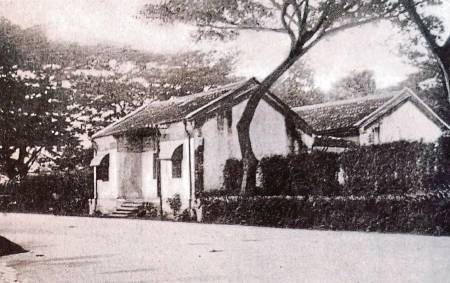
Kiri: Lebuh Pudu, penghujung Jalan Pudu, KL (1890-an): “1890s Lebuh Pudu. Supreme Court on the hill is now replaced by Maybank Tower.” (ܢܓܪ ܛܘܪܐ @ Pinterest: "1890s Lebuh Pudu").
Kanan: Hospital Tung Shin (awal kurun ke-20), di sebelah barat laut Penjara Pudu: “Tung Shin Hospital in the early 20th century along Jalan Pudu.” (Alan Teh Leam Seng @ New Straits Times, May 15, 2022: |"A glimpse into Pudu's past").
Cebisan Peristiwa
- 27/06/1894: 6 orang banduan jangka panjang berjaya meloloskan diri dari Penjara Pudu: “INFORMATION FROM THE PRISON CAPTAIN SUPERINTENDENT PERTAINING THE REGRET DUE TO THE LESS INTENTION PROVIDED FROM THE PRISON EUROPEAN WARDEN LEADING TO THE NUMBER OF CRIMINALS FROM THE KUALA LUMPUR JAIL MANAGE TO BREAKOUT.” (27/06/1894: "REPORTS ESCAPE OF 6 LONG SENTENCE PRISONERS FROM NEW GAOL PUDOH DURING THE NIGHT OF THE 26TH, 27TH INSTANCE").
- 20/07/1894: (20/07/1894: "REQUESTS THAT THE VISITING JUSTICES SHOULD VISIT THE NEW GAOL PUDOH").
- 03/05/1894: (03/05/1894: "PUDOH GAOL AND THE VISITING JUSTICE -").
- 19/02/1896: Disambar Petir: “On Wednesday night, the administration block at the Pudoh gaol was struck by lightning. An office table was smashed (the in?being upset) and then the lightning appears to have travelled the circuit of the room. Two watchmen, sleeping beneath the office, were much shaken and unnerved, but nobody was seriously injured.” (Straits Budget, 25 February 1896, Page 6: |"SELANGOR NEWS").
- 04/04/1896: “Sekeping Waran Hukuman Gantung ke atas Lee Choi di perkenan oleh Sultan Abdul Samad bertarikh 18 Februari 1896 dalam versi Bahasa Inggeris beserta Cap Mohornya. Hukuman Gantung sampai mati akan di laksanakan di dalam bilik hukuman di Penjara Kuala Lumpur (Pudu) pada pukul 8.30 pagi 4 April 1896.”

(Arkib Negara Malaysia @ Izmal Karim, 10/10/2023: "Rekod & Sejarah : Waran Hukuman Gantung di Selangor - 1896").
- 06/12/1902: Perlantikan Lembaga Jaksa Pelawat / Board of Visiting Justices bagi Penjara Pudu, yang bakal memantau operasinya bagi tahun 1903 (06/12/1902: "VISITING JUSTICES - 1903, PUDOH GAOL").
- 07/08/1903: “On Friday afternoon at abour half past three, while 240 prisoners were working in the sheds yard, outside the walls of Pudoh jail, a blinding rain squall, registering 2.5 inches in a very short time, enveloped the whole country in a sheet of mist. Armed with deadly weapons a gang of robbers suddenly dashed through the fence at the lower end of the yard where the guard was momentarily weak. A scene of great excitement resulted; most of the prisoners rushed towards the fence they had been raising and easily overpowered the preconcerned guard. Reinforcements, however, promptly checked further escapes. The Chief warder had ineffective pot-shots with a revolver at the fleeing prisoners, and, when he gave chase, tripped into a stream adjacent to the railway. A European warder faced a Chinaman armed with a parang (short sword), and, after dodging several vicious lashes, felled the prisoner to earth insensible. After the rain had stopped, before nightfall, five of the runaways, devoid of cloting, were recaptured at distances ranging from one to two miles from “home”, but twelve desperadoes undergoing long terms are still at large.” (Straits Echo, 11 August 1903, Page 3: |"PRISONERS ESCAPE FROM KUALA LUMPUR GAOL").
- 28/02/1905: J.Russell, Superintendent Jabatan Percetakan, bersetuju kegiatan penjilidan buku di Penjara Taiping diambil alih oleh Penjara Pudu, jika diurus sepenuhnya oleh Ketua Pegawai Penjara (28/02/1905: |"BOOK BINDING INDUSTRY, PUDOH GAOL").
- 15/07/1905: Laporan separuh tahun 1905 (15/07/1905: "REPORT ON THE PUDOH GAOL FOR THE 1ST HALF YEAR, 1905 -").
- 19/10/1905: Kegiatan penjilidan buku dimulakan di Penjara Pudu, atas cadangan Residen, mengikut amalan Penjara Taiping (19/10/1905: "BOOK-BINDING IN PUDOH GAOL - RE :-").
- 20/10/1905: (20/10/1905: "REPORT OF PUDOH GAOL FOR THE 3RD QUARTER 1905 - FORWARDS :-").
- 17/02/1907: Kegiatan penjilidan buku di Penjara Pudu dipindahkan ke Penjara Taiping: “Fifteen long sentenced prisoners trained in book binding with the necessary apparatus together with 5 other long sentenced prisoners were transferred to Taiping Gaol on the 28th February last.” (PEJABAT SETIAUSAHA KERAJAAN NEGERI SELANGOR, 17/02/1907: |"1. TRANSFER OF LONG SENTENCE PRISONERS FROM KUALA LUMPUR TO TAIPING 2. TRANSFER OF BOOK BUILDING MATERIALS FROM PUDU GAOL TO TAIPING").
(07/03/1907: "BOOK-BINDING AT PUDOH GAOL").
- 25/02/1908: Bilangan Penghuni: “Today there are 576 prisoners; 13 European Warders including the Chief Warder.” (PEJABAT SETIAUSAHA KERAJAAN NEGERI SELANGOR, 25/02/1908: |"NUMBER OF PRISONERS AND EUROPEAN WARDERS AT PRESENT IN THE PUDU GAOL").
- 12/10/1910: Ular sawa di berek sub-warder ditembak mati: “At about 1.10 on the morning of the 12th instant a Bengalee, while passing along the Pudoh Road from Kuala Lumpur, saw a Python coming out from the side of the Sub-Warders' Barracks of the Pudoh Gaol. As the spot was under the rays of the electric light he was able to see the reptile clearly moving with its hooded wings seeing the electric light with joy. Then the Bengalee came to the Sub-Warders' Barracks and awoke them saying that there was a big snake, who on hearing this went with big sticks of wood and saw the creature in its full shape. Fearing the creature might injure them if they were to attempt to beat with sticks, they sent for the Acting Chief Warder Mr. A.E. Gough, who in response to their call went with a gun and shot it with a No 3 bullet on its head which gave an instantaneous way for the creature to go for its rest. The Python measured 12 feet 2 inches and Mr. John Galloway has got its skin preserved.” (Pinang gazette and Straits chronicle, 26 October 1910, Page 3: |"An Amusing Report").
- 28/12/1911: Pada 19 Disember 1911, Pengerusi Lembaga Jaksa Pelawat / Board of Visiting Justices yang melawat Penjara Pudu telah menyatakan rasa tidak puas hati terhadap layanan banduan Eropah di sana, yang ada ketikanya dilayan sebagaimana banduan lain. Seminggu kemudian, setiausaha residen memberi kenyataan maaf, namun bertegas bahawa semua banduan sepatutnya menerima layanan yang sama: “I am directed to acknowledge your letter of the 19th December on the subject of an European prisoner in Kuala Lumpur prison. 2. The prisoner referred to has a cell apart from the other prisoners bathes has his meals separately and is marched off for work by himself. 3. He is employed in the stone breaking yard but not as one of the regular gang. 4. The occasion on which he was paraded with the other prisoners was a mistake on the part of a warder and will not be repeated. 5. I am to ask that in the opinion of the Resident a European in this position has already done his worst for the prestige of the race and cannot be held as deserving of special consideration. 6. It is moreover the pride of the British justice that all men are equal in the sight of the law. … - Ag: Secretary to Resident, Selangor.” (28/12/1911: |"EUROPEAN PRISONER, PUDU GAOL").
- 23/03/1915: “The Malay Mail reports that the Selangor police offer a reward of $500 in connection with information concerning four Chinese who recently escaped from the gaol at Pudoh, Kuala Lumpur, and who are still at large. Seven men broke out after assaulting the Bengali guard at the gate. He was attacked from behind and quickly overpowered. Two men hung on his rifle behind him, rendering him powerless to give an alarm by firing a shot. The others meanwhile opened the gate, and then, throwing the Bengali down, they all escaped. Once released the alarm was given and the pursuit of the men resulted in three being captured; four are still at large.” (Malaya Tribune., 23 March 1915, Page 7: |"OUTBREAK IN SELANGOR GAOL").
Cebisan Hal Ehwal Kakitangan Penjara
John Galloway: Gaoler / Ketua Pegawai Penjara KL 1891-1913
Perihal John Galloway
“John Galloway (d.1935) was the Chief Jailer at Kuala Lumpur Prisons. He dedicated 22 years of his life to the department before he went on pension on 31 May 1913, retiring to Cheltenham, England. For his meritorious service and excellent record, he was awarded the Imperial Service Order by the British government.” (Mariana Isa, Maganjeet Kaur, 2015: "Kuala Lumpur Street Names: A Guide to Their Meanings and Histories", m.s. 104).
- 10/11/1897: (10/11/1897: "RETURN FROM LEAVE OF MR. JOHN FALLOWAY GAOLER, PUDOH GAOL. REPORTS;").
- 19/11/1897: Memohon keluar setiap Ahad 5-7pm, dan ada kalanya, hari lain (19/11/1897: "MR. J. GALLOWAY GAOLER PUDOH. APPLICATION FOR PERMISSION TO BE ABSENT FROM THE GAOL PREMISES ON SUNDAY EVENINGS FROM 5 TO 7 P.M. AND WEEK DAYS (OCCASIONALLY)").
- 03/01/1900: (03/01/1900: "RE' ON MISSION OF VALUE OF QUARTERS IN COMPENSATION OF PENSION TO MR. J. GALLOWAY, GAOLER, PUDU GAOL").
- 09/05/1900: Memohon cuti untuk hal peribadi (09/05/1900: "APPLICATION FOR LEAVE FROM MR. GALLOWAY GAOLER, PUDU GAOL").
- 05/12/1902: J. Galloway (Gaoler / Pegawai Penjara), Simson (Ag.Chief Warder), Furniss, Bulmer, Hunter (Warder) menerima bonus (05/12/1902: "BONUS TO EUROPEAN WARDER, PUDOH GAOL").
- 12/12/1902: Perihal gaji (12/12/1902: "SALARY OF MR. J. GALLOWAY, GAOLER, PUDOH GAOL").
- 26/04/1912: Hasil buruan di Circular Road (kini Jalan Tun Razak), Kuala Lumpur, ialah seekor “American blue-wing teal”. Beliau mendermakannya kepada Muzium KL: “Mr. John Galloway, gaoler at Pudu, while out shooting the other evening on the Circular Road, Kuala Lumpur, bagged an American blue-wing teal. The bird is very rare and Mr. Galloway has presented it to the local museum.” (The Straits Times, 26 April 1912, Page 6: |"Untitled").
- 03/1913: Bersara dari perkhidmatan, setelah 22 tahun sebagai Ketua Pegawai / Gaoler Penjara Pudu: “Mr. R. Foster, gaoler at Batu Gajah, has been appointed to succeed Mr. J. Galloway as gaoler of Pudoh gaol, Kuala Lumpur, when the latter, after over 22 years' service, retires on pension early next month.” (Pinang gazette and Straits chronicle, 14 February 1913, Page 6: |"SOCIAL AND PERSONAL").
- 06/1913: Berpindah ke Cheltenham, Gloucestershire, England. Dia sering menderma khazanah keluarganya kepada muzium dan perpustakaan tempatan: “John Galloway from Cheltenham donated many items to Kirkcaldy Museum in 1926 in memory of his father Patrick James Galloway who was a Sheriff Clerk for Kirkcaldy. The object donated contained natural history specimens and world culture artefacts. He donated 40 Japanese and Chinese artefacts to the collection including Japanese prints, a Japanese sword and Chinese jade bracelets and ivory artefacts.” (National Museums Scotland: |"East Asia in Tayside, Central and Fife"). “Mr. John Galloway, who was an official in Kuala Lumpur for some twenty years, has presented to the local Museum a collection of curios from the F.M.S. in memory of his brother, the late Mr. Patrick James Galloway, and has also presented some fifty volumes of Malayan and Far Eastern interest to the Kirkcaldy Library. Every year, too, he presents bound volumes of magazines devoted to Malayan matters to the Library. The Museum Collection contains a piece of Chinese needlework which was part of the police court exhibits in a Secret Society Case at Kuala Lumpur. It was given to Mr. Galloway by the Superintendent of Prisons, through the courtesy of the British Resident. When Mr. Galloway was in Malaya, he took a great interest in the Kuala Lumpur Museum, and presented to it seven birds, rare to Malaya, which he shot himself. One of these is an English snipe. He is living at 217, Gloucester Road, Cheltenham, Gloucester, but spends a long annual holiday in his native town of Kirkcaldy.” (Malaya Tribune, 19 August 1932, Page 8: |"A SCOTTISH MALAYAN").
- 07/1935: Meninggal dunia di Cheltenham: “The death occured in a nursing home, in Cheltenham, last month of Mr. John Galloway, brother of the late Patrick J. Galloway, J.P., Sheriff-Clerk Depute, Kirkcaldy. The late Mr. John Galloway was formerly Gaoler, Kuala Lumpur Prisons. He retired in June 1913 and settled in Cheltenham, Glos. Galloway Road, off Pudu Road, is named after him.” (The Singapore Free Press and Mercantile Advertiser, 23 August 1935, Page 3: |"Untitled").
Peninggalan John Galloway
Jalan Galloway, Kuala Lumpur:-
- “Jalan Galloway is a minor road off Jalan Pudu in Kuala Lumpur. It is a no-through road within the Bukit Bintang neighbourhood. At its junction to Jalan Pudu is Swiss-Garden Hotel to the west side and the Kuala Lumpur Police Contingent Headquarters to the east side. Other buildings along Jalan Galloway include Swiss Garden Residences, Sri Emas Condominium, City Park Apartment and Casa Residency.” (Timothy Tye, July 2018: |"Jalan Galloway, Kuala Lumpur").
- “This road was originally occupied by government residential quarters, but today these are no longer in sight. Given its close proximity to the old Pudu Jail, there is a tendency for the name to be interpreted as “the way to the gallows”.” (Mariana Isa, Maganjeet Kaur, 2015: "Kuala Lumpur Street Names: A Guide to Their Meanings and Histories", m.s. 104).
Kakitangan Lain
- 01/02/1894: Summers - Warder: Wang Peruntukan (01/02/1894: "REGARDING ALLOWANCE ACCOUNT PUDOH GAOL TO WARDER SUMMERS").
- 26/06/1894: Sub Warders (26/06/1894: "REPORTS ON SUB WARDERS. NEW GAOL PUDOH").
- 01/11/1896: James Kirby - Warder Eropah meletak jawatan (01/11/1896: "RESIGNATION OF MR. JAMES KIRBY, EUROPEAN WARDER PUDOH GAOL FROM THE 30TH INSTANT").
- 27/11/1896: W. Siang Hock - 3rd Clerk, memohon cuti panjang selama 5 minggu (melawat keluarga, juga sering sakit) (27/11/1896: "APPLICATION FOR 5 WEEKS' LEAVE OF ABSENCE FROM W. SIANG HOCK 3RD CLERK PUDOH GAOL FOR PERMISSION TO LEAVE THE STATE").
- 03/05/1897: R.E. Gracias - memohon cuti panjang 23 hari atas sebab peribadi (03/05/1897: "FORWARDS APPLICATION OF THE 2ND CLERK PUDU GAOL FOR 23 DAYS VACATION LEAVE").
- 27/07/1897: Mr. Kydd, Acting Gaoler / Pegawai Penjara Pudu, memohon jawatan Gaoler / Pegawai Penjara Taiping (27/07/1897: "APPLICATION FROM MR. KYDD, ACTING GAOLER PUDOH GAOL FOR THE POST OF GAOLER, TAIPENG").
- 31/01/1898: Permohonan State Surgeon Selangor agar bekalan air percuma diberikan kepada para dresser yang bertugas dan tinggal di Penjara Pudu: “INFORMATION TO CHAIRMAN SANITARY BOARD, KUALA LUMPUR PERTAINING THE CASE REPORTED BY THE MEDICAL STAFF, WHICH THERE IS NO NEED TO PAY FOR THE FACILITY CHARGE DUE TO NO PIPE WAS LAID ON THEIR HOUSE.” (SETIAUSAHA KERAJAAN NEGERI SELANGOR, 31/01/1898: |"DRESSERS AT PUDU GAOL. REQUESTS THAT THEY BE EXEMPTED FROM PAYMENT OF WATER RATE").
- 07/02/1898: Mr. Burton - Warder ditawarkan menjadi Inspektor Polis Pahang, dan menerimanya: (07/02/1898: "OFFERS MR. BURTON WARDER PUDOH GAOL THE POST OF INSPECTOR OF POLICE PAHANG").
- 07/03/1898: Dixon dari Penjara Taiping - Dilantik Ketua Warder Penjara Pudu (07/03/1898: "APPOINTMENT OF WARDER, DIXON OF THE CENTRAL PRISON STAFF, TAIPING AS CHIEF WARDER, PUDOH GAOL").
- 07/03/1898: G.E. Easy dari Singapura - Permohonan jawatan Warder Eropah (07/03/1898: "APPLIES FOR THE POST OF EUROPEAN WARDER PUDU GAOL").
- 07/03/1898: A. Lyons dari Singapura - Permohonan jawatan Warder Eropah (07/03/1898: "APPLIES FOR THE APPOINTMENT OF WARDER PUDU GAOL SELANGOR").
- 07/03/1898: A. Van Tooren dari Pulau Pinang - Permohonan jawatan Warder Eropah (07/03/1898: "APPLIES FOR THE POST OF EUROPEAN WARDER PUDU GAOL").
- 08/03/1898: E.G. Bennett - Memohon jawatan Warder (08/03/1898: "APPLIES FOR THE POST OF WARDER PUDU GAOL").
- 10/03/1898: Permohonan jawatan Warder Eropah: (10/03/1898: "EUROPEAN WARDER PUDU GAOL - APPLICATION FOR THE POST OF;").
- 13/03/1898: Private Harry (H.) Robinson dari Singapura - memohon jawatan warder Eropah (13/03/1898: |"EUROPEAN WARDER PUDU GAOL - APPLICATION FOR THE POST OF;").
- 13/03/1898: E.L. Koeneman dari Pulau Pinang - memohon jawatan Warder Eropah (05/03/1898: |"APPLIES FOR THE POST OF EUROPEAN WARDER PUDU GAOL").
- 13/03/1898: A. Barnett - Memohon jawatan Warder Eropah (13/03/1898: "EUROPEAN WARDER PUDU GAOL - APPLICATION FOR THE POST OF;").
- 19/03/1898: B. Dixon - Ketua Warden yang baru melapor diri: “NOTIFICATION BY THE ACTING SUPERINTENDENT OF PRISONS, TAIPING, CONCERNING THE ARRIVAL OF AN OFFICER TO TAKE UP HIS RECRUITMENT AS THE CHIEF WARDEN.” (19/03/1898: "REPORTS ARRIVAL OF MR. B. DIXON, CHIEF WARDER, PUDU GAOL").
- 14/04/1898: B. Dixon - Warder Penjara Larut dipindahkan sebagai Ketua Warder, Penjara Pudu (14/04/1898: "RECORD SHEETT AND PAY CERTIFICATE OF MR. B. DIXON LATE WARDER, CENTRAL PRISON, LARUT TRANSFERRED TO SELANGOR AS CHIEF WARDER, PUDOH GAOL. FORWARDS;").
- (11/05/1898: "EUROPEAN WARDERS FOR PUDOH GAOL").
- 12/08/1898: Permohonan Warder Eropah (12/08/1898: "EUROPEAN WARDERSHIP, PUDOH GAOL. APPLICATION FOR").
- 13/10/1898: Permohonan Warder Eropah (13/10/1898: "APPLICATIONS FOR EUROPEAN WARDER, PUDU GOAL").
- 08/12/1898: (08/12/1898: "SUBMIT REGULATIONS DEALING WITH AN ' OUTBREAK ' AND RECOMMEND THAT THEY BE ADOPTED AT PUDOH GAOL.")
- 18/09/1899: Corporal Parry - Dilantik sebagai Warder Eropah (18/09/1899: "APPOINTMENT OF CORPORAL PARRY AS EUROPEAN WARDER, PUDU GAOL").
- 18/12/1899: Tambi bin Sedin, warder tempatan, membeli tanah di Batu 1 Jalan Pudu: “In accordance with G.O 30 & 31 I have the honor to report that the Chief Native Warder Tenbi bin Seedin has purchased land at 1st mile on the Pudu Road. … - A.S. Laurence(?) Capt., Acting Supt. Prisons.” (18/12/1899: |"REPORTS THAT CHIEF NATIVE WARDER, TAMBI BIN SEDIN HAS PURCHASED LAND AT 1ST MILE PUDU ROAD").
- 25/04/1900: Chong Lan Fong - memohon jawatan Clerk / Storekeeper (25/04/1900: "APPLIES FOR POST OF CLERK AND STOREKEEPER, PUDU GAOL").
- 25/09/1901: T.W. Talbot - Dilantik ketua sementara (25/09/1901: "MR. T.W. TALBOT TO TAKE TEMPORARY CHARGE OF PUDOH GAOL").
- 17/12/1901: R. Hunter (Guard Railway) - memohon jawatan Warden Eropah (17/12/1901: "APPLICATION FROM MR. R. HUNTER, GUARD RAILWAY FOR THE POST OF EUROPEAN WARDEN, PUDOH GAOL").
- 09/09/1902: R. Greer - Bekas Warden Eropah - permohonan pampasan: “SUBMISSION BY THE ACTING SECRETARY TO RESIDENT TO THE SECRETARY TO THE RESIDENT GENERAL REGARDING THE VOUCHER FOR $54.27, AND ASKS FOR THE MONEY ORDER BE SUBMITTED TO MR. GREEN.” (09/09/1902: "PETITION OF MR. GREEN, EX WARDER, PUDOH GAOL, RE HIS SALARY TO BE PAID AT DOUBLE COMPENSATION RATES. INFORMATION REQUIRED RE:").
- 04/11/1902: A.E. Gough - dilantik Warder Eropah “INFORMATION PREPARED BY THE ACTING BRITISH RESIDENT REGARDING AN APPOINTMENT OF MR. A.E GOUGH WHO SERVES AS A EUROPEAN WARDER AT PUDOH GAOL WITH AN AUTHORIZED SALARY COST OF $110 WITHIN SIX MONTHS PROBATION AND TRANSMITTED COPIES OF MR A.E GOUGH'S EXPERIENCES.” (04/11/1902: "APPLICATION OF MR. A.E. GOUGH AS EUROPEAN WARDER - PUDOH GAOL").
- 04/11/1902: E.A. Gregory - dilantik Warder Eropah (04/11/1902: "APPOINTMENT OF MR. E.A. GREGORY AS EUROPEAN WARDER - PUDOH GAOL").
- 16/11/1902: C.H. Wyatt - dilantik Warder Eropah (16/11/1902: "APPOINTMENT OF MR. C.H. WYATT AS EUROPEAN WARDER, PUDOH GAOL").
- 19/12/1902: “REPORT PREPARED BY THE INSPECTOR OF PRISONS ON HIS INSPECTION VISIT TO THE KUALA LUMPUR JAIL AND HIS VIEWS ON SEVERAL MATTERS SUCH AS THE POWERS OF THE SUPERINTENDENT, SOLITARY CONFINEMENT, PRISONERS' PERSONAL EFFECTS, DISCIPLINE AND THE DELAY IN SALARY FOR THE EUROPEAN WARDERS.” (19/12/1902: "INSPECTION OF PUDOH GAOL ON 7TH DECEMBER 1902 - REPORT ON :-").
- 30/12/1902: F.W. Parry - Perlantikan sebagai Warder Eropah (30/12/1902: "APPOINTMENT OF MR. F.W. PARRY AS EUROPEAN WARDER, PUDOH GAOL").
- 03/01/1903: “The following notifications have been gazetted in Selangor:- Mr E. A. Gregory to be European warder, Pudoh Goal. Me. A.E. Gough to be European warder, Pudoh Goal.” (The Straits Times, 3 January 1903, Page 4: |penjara_pudu_awal).
- 03/01/1903: Sarjan Ali - Perihal hutangnya (03/01/1903: "JUDGMENT DEBTOR - DECEMBER 1902 - SERGEANT ALI - PUDOH GAOL").
- 26/01/1903: Penambahan 8 orang Sub-Warder (26/01/1903: "EXTRA SUB-WARDERS, PUDOH GAOL. SUPPLEMENTARY VOTE $1500").
- 24/06/1903: Hamza bin Raham - Warder tempatan, bersara (24/06/1903: "HAMZA, NATIVE WARDER, PUDOH GAOL - RETIREMENT ON GRATUITY").
- 13/11/1903: Samunder Khan - Bekas Sub-Warder memohon gaji bulan September (Tidak diluluskan): “THE ACTING SECRETARY TO RESIDENT'S REPLY TO THE PETITIONER SAMUNDER KHAN ON HIS REQUEST FOR HIS SALARY TO BE PAID WAS DISAPPROVED DUE TO HIS DISMISSAL FROM THE PRISON STAFF AS MENTIONED IN PRISON ENACTMENT 1903.” (13/11/1903: "PETITION FROM SAMUNDER KHAN, EX SUB-WARDER, PUDOH GAOL, FOR PAYMENT OF SEPTEMBER SALARY").
- 16/08/1904: A.H.Lloyd - Disahkan sebagai Warder Eropah (16/08/1904: "CONFIRMATION OF MR. A.H. LLOYD AS EUROPEAN WARDER, PUDOH GAOL").
- 11/09/1905: George Wright - Dilantik Warder Eropah (11/09/1905: "APPOINTMENT OF MR. GEORGE WRIGHT AS EUROPEAN WARDER PUDOH GAOL - MAKE ENQUIRY REGARDING").
- 18/02/1907: Warder Penjara Seremban Dipenjarakan: “Warder Vaughan of Seremban sentenced this morning to one month simple imprisonment undesirable he should be imprisoned here resident will be obliged if you will consent to this admittance to pudu gaol where a.s.p. reports accomodation available he leaves by one o'clock train today and a.s.p. Kuala Lumpor has been informed.” (PEJABAT SETIAUSAHA KERAJAAN NEGERI SELANGOR, 18/02/1907: |"TELEGRAM - WARDER VAUGHAN SENTENCED TO ONE MONTHS IMPRISONMENT - ASKS THAT HE BE DETAINED IN PUDU GAOL").
- 01/02/1908: Mr Bailey - Perlantikan sebagai Warder Eropah (PEJABAT SETIAUSAHA KERAJAAN NEGERI SELANGOR, 01/02/1908: "APPOINTMENT OF MR. BAILEY AS EUROPEAN WARDER PUDU GAOL").
- 1911: Richard Alfred Ernest Clark - Warder Eropah: “In 1911, Richard Alfred Ernest Clark, a former soldier of the third battalion of the Middlesex Regiment, was one of the European warders at Pudu Prison.” (Wikipedia).
- 10/02/1912: Rahamat Tullah - petisyen rayuan pemberhentian jawatan Sub-Warder (PEJABAT SETIAUSAHA KERAJAAN NEGERI SELANGOR, 10/02/1912: "PETITION RE HIS DISMISSAL AS SUB-WARDER IN THE PUDU GAOL").
- 03/1919: William Towle - Warder Penjara Pudu, dilantik menjadi Superintenden Pasukan Bomba Selangor: “RECOMMENDATION FROM THE CHAIRMAN SANITARY BOARD KUALA LUMPUR FOR MR. WILLIAM TOWLE, A PUDU JAIL WARDER TO BE APPOINTED AS THE SUPERINTENDENT OF SELANGOR FIRE BRIGADE WHICH WAS APPROVED BY THE HIGH COMMISSIONER IN MARCH 1919.” (PEJABAT SETIAUSAHA KERAJAAN NEGERI SELANGOR, 24/01/1919: |"MR. WILLIAM TOWLE, WARDER, PUDU JAIL, TO BE APPOINTED SUPERINTENDENT OF SELANGOR FIRE BRIGADE").
Cebisan Hal Ehwal Banduan
- 18/07/1894: 6 orang banduan jangka panjang berjaya melepaskan diri dari Penjara Pudu (18/07/1894: "REPORTS AN ESCAPE OF 6 LONG SENTENCED CHINESE PRISONERS NEW GAOL PUDOH. FORWARDS: -").
- 19/07/1894: (19/07/1894: "RE WORKING OF PRISONERS AT NEW GAOL PUDOH").
- 01/08/1895: Ng Chin (No. 35) - Meloloskan diri dari penjara (01/08/1895: "REPORTS THAT PRISONER NG CHIN N'L 35 ESCAPES FROM THE PUDOH GAOL ON THE 39TH ULTIMO").
- 02/11/1896: Tan Hian (No. 1921) - Percubaan membunuh diri (02/11/1896: "ATTEMPT AT SUICIDE AT PUDOH GAOL BY STRAITS SETTLEMENTS PRISONER NO.1921 TAN HIAN - REPORTS").
- 06/02/1897: Chua Tua Taw - membunuh diri dengan terjun dari tingkat dua block D: “The condemned prisoner Chua Tua Taw has committed suicide by throwing himself over the 2nd landing on D. Block of the Pudoh Gaol. This took place about 10.45a.m. on Saturday. The man lingered four hours after his fall. That a condemned prisoner should have had the chance of performing this feat, does not seem quite in the right order of things.” (The Singapore Free Press and Mercantile Advertiser (Weekly), 16 February 1897, Page 7: | "THURSDAY, FEBRUARY 11, 1897").
- 16/03/1897: Lew Sang (Keh) - petisyen pembebasan, oleh keluarga Chop, diketuai Chop Sin Muin (16/03/1897: "PRAY FOR THE RELEASE OF ONE LEW SANG (KEH) OF PUDOH").
- 07/07/1897: Mulla Singh - permohonan melawat oleh bapanya, Shur Singh (07/07/1897: "PRAYS THAT HE MAY BE ALLOWED TO VISIT HIS SON, MULLA SINGH, A CONVICT IN THE PUDOH GAOL").
- 07/11/1897: “REQUEST TO THE BRITISH RESIDENT NEGERI SEMBILAN TO FORWARD THE REGULATION RELATED TO THE CONVICT THAT HAS BEEN JAILED FOR LIFE.” (07/11/1897: "TRANSFER OF PREMIER UNDER LIFE SENTENCE TO PUDOH GAOL").
- 07/12/1898: Mawan Kamar bin Salleh - Permohonan pemindahan hak milik tanahnya kepada anaknya. Ianya tidak diluluskan atas perkiraan “adat”: “A prisoner named Mawan Kamar bin Salleh in Seremban Gaol has 2 kauq(?) of sawah and kampong at Kampong Tanjong Rembau he wants to transfer the land to his daughter Saibar bin Mawan Kamar but says names of grants were changed to Mear bin Samin of R. Tanjong when (he) M. Kamar went to Pahang in 1894.” (PEJABAT SETIAUSAHA KERAJAAN NEGERI SELANGOR, 07/12/1898: |"SUBMITS CORRESPONDENCE WITH REGARD TO A TRANSFER OF SOME LAND BY A PRISONER IN PUDU GAOL").
- 09/01/1899: Orang Melayu Pertama Dihukum Gantung: “A Malay and a Javanese, who each had murdered a woman, were both hanged at Pudoh jail on Monday. This is said to be the first time a Malay has ever been hanged in Kuala Lumpur.” (Straits Budget, 12 January 1899, Page 5: |"SELANGOR NEWS").
- 01/04/1901: Permohonan lawatan oleh beberapa orang (PEJABAT SETIAUSAHA KERAJAAN NEGERI SELANGOR, 01/04/1901: "ASKS PERMISSION FOR TAP PAO KIAW AND CHONG LAM TO SEE TAP PAO WHO IS IN PUDU GAOL PENDING BANISHMENT").
- 29/04/1901: Permohonan pemindahan 20 orang banduan jangka panjang dari Penjara Negri Sembilan (29/04/1901: "ENQUIRES IF SO LONG SENTENCE PRISONERS CAN BE INCARCERATED IN THE PUDOH GAOL").
- 21/05/1901: (21/05/1901: "TELEGRAM - ENQUIRES IF THERE IS ANY ACCOMMODATION IN PUDOH GOAL FOR A PRISONER UNDER SENTENCE OF DEATH").
- 19/10/1901: Chua Leung, Chua Meng - Permohonan lawatan (19/10/1901: "ASKS PERMISSION TO VISIT PRISONERS CHUA LEUNG AND CHUA MENG IN PUDOH GAOL").
- 07/02/1902: “NOTIFICATION FROM STATE SURGEON REGARDING THE ADMITTANCE OF ELEVEN TRAMPS TO PUDU GAOL WITH THE APPROVAL AND SUGGESTION OF BRITISH RESIDENT ON ANY OBJECTION SHOULD BE VOICED OUT IN ORDER TO AVOID THE UNNECESSARY FEELING.” (PEJABAT SETIAUSAHA KERAJAAN NEGERI SELANGOR, 07/02/1902: "REPORTS ADMISSION OF ELEVEN VAGRANTS TO PUDU GAOL").
- 15/10/1902: Lee Tam - Permohonan lawatan oleh Lee Chuan (15/10/1902: |"PERMISSION TO VISIT PRISONER LEE TAM IN PUDOH GAOL").

- 22/10/1902: Ho Yoo - petisyen rayuan isterinya Yip Ah Lin, agar dibebaskan dari hukuman 6 bulan penjara (+2 bulan kerana cuba melepaskan diri), kerana kesalahannya hanyalah lesen memotong kayu tamat 2 hari (22/10/1902: "PETITION FOR RELEASE OF HER HUSBAND HO YOO, PRISONER IN PUDOH GAOL").
- 07/08/1903: “Yesterday during heavy rain, fifteen prisoners escaped from Pudoh gaol. It is reported that some have been recaptured.” (Straits Echo, 8 August 1903, Page 2: |"BREAKING GAOL").
- 18/03/1904: Chan Ng - Petisyen pengurangan baki tempoh hukuman (18/03/1904: "PETITION FROM CHAN NG, PRISONER PUDOH GAOL FOR REMISSION OF REMAINING SENTENCE -").
- 28/07/1904: 2 orang banduan berjaya melepaskan diri akibat kelemahan pada binaan (28/07/1904: "ESCAPE OF TWO PRISONERS FROM D. HALL PUDOH GAOL -").
- 01/02/1905: 2 orang banduan yang digari bersama mengalami kemalangan di stesen kereta api Pudu akibat kesilapan kakitangan stesen dan kereta api yang mereka naiki (01/02/1905: | "ACCIDENT TO TWO PRISONERS AT PUDOH RAILWAY STATION").
- 17/02/1908: Tai Kee Fuk - petisyen agar tidak dibuang negeri. Petisyen dilengkapi cop perniagaan rakan-rakan peniaganya yang telah mengenalinya selama 6 tahun, dan turut disokong oleh pegawai Protector of Chinese. Menurut petisyen tersebut, Tai Kee Fuk, seorang pekedai teh (juga penjual daging babi) di Serdang, telah menyewakan tingkat atas kedainya kepada beberapa orang, yang kebetulan adalah ahli kongsi gelap. Pada 2-3 Ogos 1907 kedai beliau telah digeledah oleh pihak berkuasa dan sebuah buku yang telah diharamkan ditemui di dalam premis. Beliau terus didakwa di mahkamah dan gagal membela diri oleh kerana terlalu takut, lalu ditahan di Penjara Pudu. Setelah tempohnya kian tamat, keluarganya (termasuk isteri dan anak kecil) mendapat tahu bahawa beliau bakal dibuang negeri.Rekod hukuman tidak ditemui, tidak pasti apakah kesudahannya (PEJABAT SETIAUSAHA KERAJAAN NEGERI SELANGOR, 17/02/1908: |"PETITION ASKING THAT TAI KEE FUK, NOW IN THE PUDU GOAL, BE NOT BANISHED FROM SELANGOR").
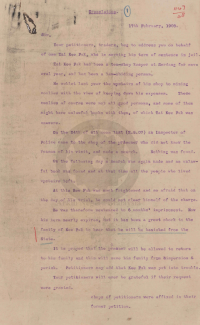
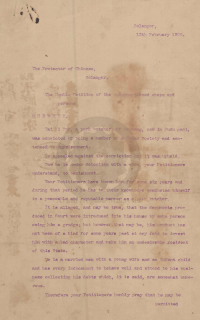
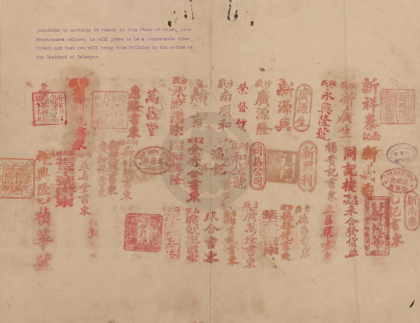
- June 1911: Ethel Proudlock
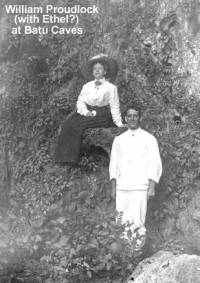
“This incident caused a sensation in Malaya, more so than any other as this involved the killing of one member of the British community by another. The case was even reported in the newspapers in England where, presumably, Mr Bennett Shaw would have been aghast to read of the dreadful goings-on at his own bungalow! There was a ten-day trial in June, 1911, which attracted intense public attention and was reported in great detail in the local papers. William Proudlock himself had to testify at the trial as well. In court, Ethel claimed that Steward had tried to molest her and, as she backed away from him, she came on to her husband's revolver and had fired at Steward in self-defence. Nonetheless, Ethel was found guilty by the judge and sentenced to death. While awaiting her appeal, she was incarcerated in Pudu Jail for five months before various petitions to the Sultan of Selangor, including one from the V.I. boys and masters, were finally successful in securing her release. Ethel then sailed off almost immediately to England with Dorothy. William Proudlock stayed behind in Kuala Lumpur as he was awaiting the results of a libel charge he had filed arising from police treatment of his wife. He lost this suit and resigned his job at the V.I. (Mr Shaw had since returned). He sailed off to England in November, 1911, to rejoin his family. In seven months, the world of the V.I. acting Headmaster had withered to nothing.” (Chung Chee Min, 28 August 2001: |"The Proudlock Saga").
Sumber akhbar: The Singapore Free Press and Mercantile Advertiser (1884-1942), 12 July 1911, Page 8: |"KUALA LUMPUR TRAGEDY".
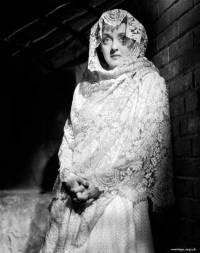
“Classic screen actress Bette Davis in a scene from the 1940 film-noir set in Malaya, 'The Letter'. The film is based on the play and short story written by W. Somerset Maugham, who in turn based it on the real life murder trial of Ethel Proudlock in Kuala Lumpur in 1911. Ethel Proudlock was the wife of the acting headmaster of the Victoria Institution, William Proudlock. Ethel shot dead her lover, William Steward, a mine manager, and in the trial was found guilty and sentenced to hang, to much controversy. The infamous case caused a worldwide sensation, scandalising British colonial society and prompting accusations of racism from the local community when it emerged that Ethel was in fact not white but Eurasian. After spending about five months in Pudu Jail awaiting her appeal, she was subsequently pardoned by Sultan Sulaiman of Selangor and left the Federated Malay States for England and, later, America.” (Sabri Zain's Malayan History Society @ Facebook, 28 Disember 2023: |"Classic screen actress Bette Davis in a scene from the 1940 film-noir set in Malaya, 'The Letter'").
Cebisan Hal Ehwal Pembekal
- 25/06/1903: “NOTIFICATION BY ACTING STATE ENGINEER TO THE SECRETARY TO RESIDENT PERTAINING TO THE DETAILS FOR INVITING TENDERS FOR THE EXPANSION OF OFFICERS' BUILDING AND REQUESTS IT TO BE INSERTED IN THE GOVERNMENT DOCUMENT AND PRINT IT FOR DISTRIBUTION PURPOSES AMONG THE CONTRACTORS.” (25/06/1903: "BARRACKS FOR SUB-WARDERS, PUDOH GAOL - TENDERS INVITED FOR :-").
- 26/06/1903: “A RECOMMENDATION FROM THE STATE SURGEON TO THE SECRETARY TO RESIDENT TO CALL OF CONTRACTORS FOR THE SUPPLY OF FOOD FOR PUDU PRISON BE HANDLED BY THAT FACILITY'S ADMINISTRATION AND NOT BY HIM AS IT WILL CUT THE OVERALL COST OF THE CONTRACT AND ATTRACTS CONTRACTORS TO BID FOR THE CONTRACT.” (26/06/1903: "SEPARATE TENDERS FOR SUPPLY OF RATIONS & C., PUDOH GAOL TO BE CADET CALLED BY SUPERINTENDENT OF PRISONS").
- 24/11/1903: “PETITION MADE BY KALA SINGH TO THE SECRETARY TO RESIDENT PERTAINING TO THE COMPLAINT IN WHICH SOME PEOPLE IMPOSE NEW TENDER WITH CHEAPER RATE AND TRY TO TAKE THE CONTRACT OWNED BY HIM FOR THE SUPPLY OF MILK TO MEDICAL CENTER AND PRISON AT KUALA LUMPUR.” (24/11/1903: "MILK SUPPLY TO GENERAL HOSPITAL, PAUPER HOSPITAL AND PUDOH GAOL - PETITION RE -").
- 20/12/1911: Kontraktor pembekal makanan memohon pampasan akibat kenaikan harga beras di pasaran (PEJABAT SETIAUSAHA KERAJAAN NEGERI SELANGOR, 20/12/1911: "ENQUIRES WHETHER THE PUDU GAOL CONTRACTOR HAS BEEN GRANTED COMPENSATION FOR THE HIGH PRICE OF RICE").
- 23/12/1911: Towkay Lee Ho Yee, Chop Sang Chong, 3 Klyne Street, KL - Dianugerahi kontrak pembekalan makanan penjara bagi tahun 1912 (14/12/1911: "RE HIS TENDER FOR THE SUPPLY OF RATIONS, PUDU GAOL, 1912").
| Laman Utama | Hubungi Kami | ||||||||
| Siri Cebisan Sejarah: | Bangi | Gambang | Hutan | Ipoh | Kajang | Kuala Lumpur | Kuantan | Pulau Pinang | Hubungi Kami |